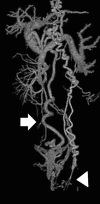Transileocolic vein obliteration for bleeding rectal varices with portal thrombus
- PMID: 23626507
- PMCID: PMC3617969
- DOI: 10.1159/000348761
Transileocolic vein obliteration for bleeding rectal varices with portal thrombus
Abstract
We report a case of rectal varices treated successfully with transileocolic vein obliteration (TIO). A 70-year-old man was admitted to our hospital for evaluation of fresh bloody stools in January 2011. Emergent colonoscopy revealed fresh blood in the rectum and tortuous rectal varices. Three-dimensional computed tomography was used as a non-invasive method for the identification of rectal varices and thrombus in the extrahepatic portal vein. Angiography demonstrated that rectal varices were supplied with backward blood flow by the inferior mesenteric vein. Transileocolic variceal obliteration was performed using coils and 5% ethanolamine oleate with iopamidol. Complete hemostasis was achieved without complications. We conclude that TIO is a safe and effective hemostatic measure for ruptured rectal varices with portal thrombus.
Keywords: Portal thrombus; Rectal varices; Transileocolic vein obliteration.
Figures



Similar articles
-
The First Transileocolic Obliteration for Refractory Esophageal Varices: A Case Report and Review of the Literature.Intern Med. 2022 Mar 15;61(6):835-839. doi: 10.2169/internalmedicine.7620-21. Epub 2021 Aug 31. Intern Med. 2022. PMID: 34471019 Free PMC article. Review.
-
Combination of transileocolic vein obliteration and balloon-occluded retrograde transvenous obliteration is effective for ruptured duodenal varices.J Gastroenterol. 1999 Dec;34(6):694-9. doi: 10.1007/s005350050321. J Gastroenterol. 1999. PMID: 10588186
-
Emergency transileocolic vein obliteration for life-threatening bleeding from gastric varices.Radiol Case Rep. 2023 Feb 10;18(4):1570-1575. doi: 10.1016/j.radcr.2023.01.045. eCollection 2023 Apr. Radiol Case Rep. 2023. PMID: 36824993 Free PMC article.
-
Appearance of rectal varices in extrahepatic portal obstruction after treatment for esophago-gastric varices: a case report.Fukushima J Med Sci. 2002 Jun;48(1):51-6. doi: 10.5387/fms.48.51. Fukushima J Med Sci. 2002. PMID: 12365598
-
Management of rectal varices in portal hypertension.World J Hepatol. 2015 Dec 28;7(30):2992-8. doi: 10.4254/wjh.v7.i30.2992. World J Hepatol. 2015. PMID: 26730278 Free PMC article. Review.
Cited by
-
Successful hemostasis of intractable rectal variceal bleeding using variceal embolization.World J Gastroenterol. 2015 Feb 28;21(8):2558-62. doi: 10.3748/wjg.v21.i8.2558. World J Gastroenterol. 2015. PMID: 25741168 Free PMC article.
-
Percutaneous Transhepatic Embolization of Bleeding Rectal Varices Using A New Embolic And Sclerotic Mixture Augmented By Amplatzer Vascular Plug 2.J Radiol Case Rep. 2016 Sep 30;10(9):44-51. doi: 10.3941/jrcr.v10i9.2580. eCollection 2016 Sep. J Radiol Case Rep. 2016. PMID: 27761198 Free PMC article.
-
Treating Untreatable Rectal Varices.GE Port J Gastroenterol. 2019 Oct;26(6):420-424. doi: 10.1159/000496121. Epub 2019 Feb 15. GE Port J Gastroenterol. 2019. PMID: 31832497 Free PMC article.
-
Pipeline Esophagogastric Varices Secondary to Extrahepatic Portal Vein Obstruction Treated Endoscopically with the Assistance of Transileocolic Obliteration.Intern Med. 2022 Dec 1;61(23):3503-3511. doi: 10.2169/internalmedicine.9404-22. Epub 2022 Apr 30. Intern Med. 2022. PMID: 35491134 Free PMC article.
-
The First Transileocolic Obliteration for Refractory Esophageal Varices: A Case Report and Review of the Literature.Intern Med. 2022 Mar 15;61(6):835-839. doi: 10.2169/internalmedicine.7620-21. Epub 2021 Aug 31. Intern Med. 2022. PMID: 34471019 Free PMC article. Review.
References
-
- Hosking SW, Smart HL, Johnson AG, et al. Anorectal varices, hemorrhoids, and portal hypertension. Lancet. 1989;18:349–352. - PubMed
-
- Watanabe N, Toyonaga A, Kojima S, et al. Current status of ectopic varices in Japan: results of a survey by the Japan Society for portal hypertension. Hepatol Res. 2010;40:763–776. - PubMed
-
- Johansen K, Bardin J, Orloff MJ. Massive bleeding from hemorrhoidal varices in portal hypertension. JAMA. 1980;244:2084–2085. - PubMed
-
- Herman BE, Baum S, Denobile J, et al. Massive bleeding from rectal varices. Am J Gastroenterol. 1993;88:939–942. - PubMed
-
- Levine J, Tahiri A, Banerjee B. Endoscopic ligation of bleeding rectal varices. Gastrointest Endosc. 1993;39:188–190. - PubMed
Publication types
LinkOut - more resources
Full Text Sources
Other Literature Sources

